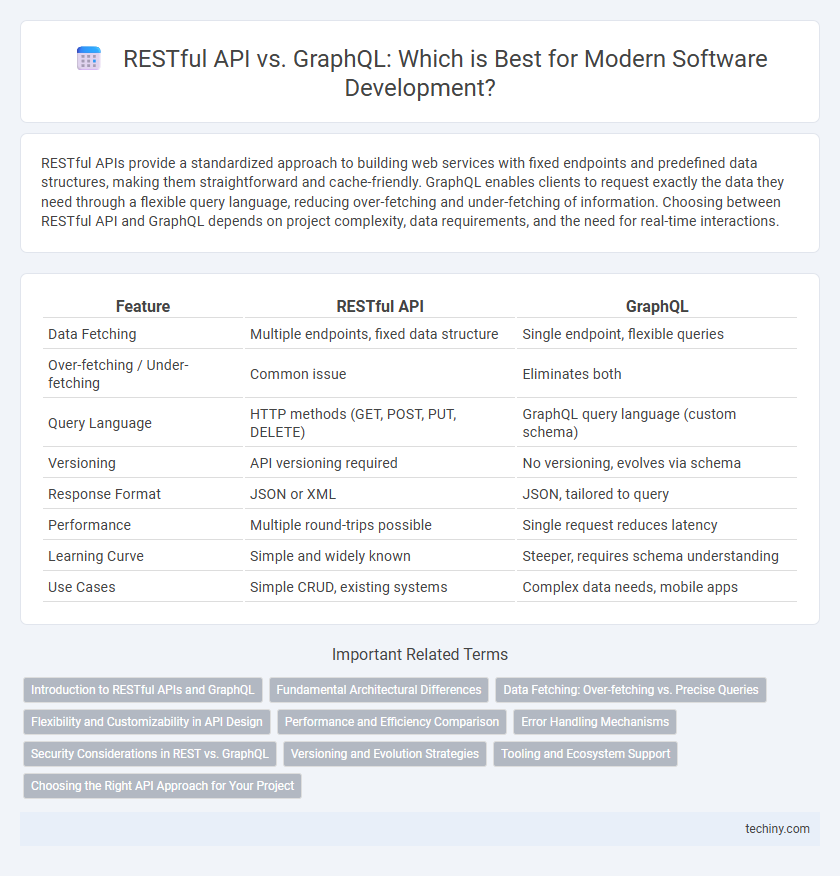RESTful APIs provide a standardized approach to building web services with fixed endpoints and predefined data structures, making them straightforward and cache-friendly. GraphQL enables clients to request exactly the data they need through a flexible query language, reducing over-fetching and under-fetching of information. Choosing between RESTful API and GraphQL depends on project complexity, data requirements, and the need for real-time interactions.
Table of Comparison
| Feature | RESTful API | GraphQL |
|---|---|---|
| Data Fetching | Multiple endpoints, fixed data structure | Single endpoint, flexible queries |
| Over-fetching / Under-fetching | Common issue | Eliminates both |
| Query Language | HTTP methods (GET, POST, PUT, DELETE) | GraphQL query language (custom schema) |
| Versioning | API versioning required | No versioning, evolves via schema |
| Response Format | JSON or XML | JSON, tailored to query |
| Performance | Multiple round-trips possible | Single request reduces latency |
| Learning Curve | Simple and widely known | Steeper, requires schema understanding |
| Use Cases | Simple CRUD, existing systems | Complex data needs, mobile apps |
Introduction to RESTful APIs and GraphQL
RESTful APIs operate on stateless communication principles using standard HTTP methods like GET, POST, PUT, and DELETE for resource manipulation, providing simple and scalable interface architecture. GraphQL offers a flexible query language that allows clients to request exactly the data needed, reducing over-fetching and under-fetching issues common in REST. Both enable efficient client-server interactions but differ in data retrieval patterns and flexibility, making the choice dependent on specific application requirements.
Fundamental Architectural Differences
RESTful API relies on multiple endpoints exposing fixed data structures, using HTTP methods like GET, POST, and DELETE to manipulate resources, while GraphQL uses a single endpoint allowing clients to specify precisely the data shape through queries and mutations. REST follows a stateless client-server architecture with resource-based URLs, whereas GraphQL operates as a query language over HTTP, enabling flexible data retrieval in a single request. These fundamental architectural differences impact performance, scalability, and the complexity of data fetching in software development.
Data Fetching: Over-fetching vs. Precise Queries
RESTful APIs often lead to over-fetching by returning fixed data structures, causing clients to receive unnecessary information and increased payload sizes. GraphQL enables precise queries by allowing clients to specify exact fields needed, optimizing data transfer and improving application performance. This targeted data fetching reduces bandwidth usage and accelerates front-end rendering, enhancing user experience.
Flexibility and Customizability in API Design
RESTful APIs offer fixed endpoints with defined responses, which simplifies caching and scalability but limits query flexibility. GraphQL enables clients to specify exact data requirements through a single endpoint, enhancing customizability and reducing over-fetching or under-fetching of data. This flexibility makes GraphQL ideal for applications requiring dynamic queries and efficient data retrieval across complex relationships.
Performance and Efficiency Comparison
RESTful APIs often involve multiple round-trips to different endpoints, which can lead to increased latency and over-fetching of data. GraphQL optimizes performance by allowing clients to request exactly the needed data in a single query, reducing network overhead and improving loading times. However, GraphQL servers may introduce complexity in query resolution, potentially impacting response time depending on query depth and resolver efficiency.
Error Handling Mechanisms
RESTful API error handling typically uses standard HTTP status codes to indicate success or failure, with supplementary error messages in the response body providing additional context. GraphQL centralizes error handling within a single response structure, combining data and errors arrays to deliver partial results alongside detailed error information. This approach allows GraphQL to offer more granular error feedback, especially for complex queries involving multiple resources, improving client-side error management and debugging.
Security Considerations in REST vs. GraphQL
RESTful APIs implement security through standard HTTP methods and status codes, leveraging OAuth 2.0 and OpenID Connect for authentication and authorization, but might expose multiple endpoints increasing attack surface. GraphQL consolidates data queries into a single endpoint, which simplifies security enforcement but requires careful query complexity analysis and depth limiting to prevent denial-of-service attacks. Both architectures demand robust input validation, rate limiting, and proper error handling to mitigate injection attacks and data exposure vulnerabilities.
Versioning and Evolution Strategies
RESTful APIs typically handle versioning through URL path changes or header versions, which can lead to multiple maintained versions and potential deprecation challenges. GraphQL evolution strategies emphasize a single evolving schema using deprecations and non-breaking changes, minimizing the need for explicit versioning. This approach reduces client-side disruptions and streamlines API evolution by enabling backward-compatible feature additions and gradual migration.
Tooling and Ecosystem Support
RESTful APIs benefit from mature tooling and extensive ecosystem support, featuring robust client libraries, widespread server frameworks, and comprehensive monitoring tools that streamline development and maintenance. GraphQL offers powerful developer tools such as GraphiQL and Apollo Client, enabling precise data queries and schema introspection, which enhance API exploration and debugging. Although GraphQL's ecosystem is rapidly growing, REST's established infrastructure provides broader compatibility and integration options across diverse platforms and services.
Choosing the Right API Approach for Your Project
Selecting between RESTful API and GraphQL depends on project requirements such as data complexity, flexibility, and performance needs. RESTful APIs offer simplicity and cacheable endpoints ideal for predictable, resource-based interactions, while GraphQL provides efficient data retrieval with single endpoint queries tailored for complex and dynamic data structures. Evaluating factors like client-server communication patterns, development speed, and scalability guides the choice for optimal API integration.
RESTful API vs GraphQL Infographic

 techiny.com
techiny.com